Exploring Dubai's Mediterranean-Inspired Sports City
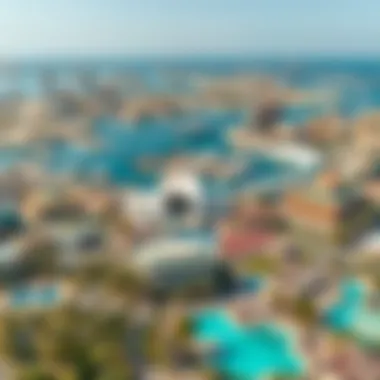
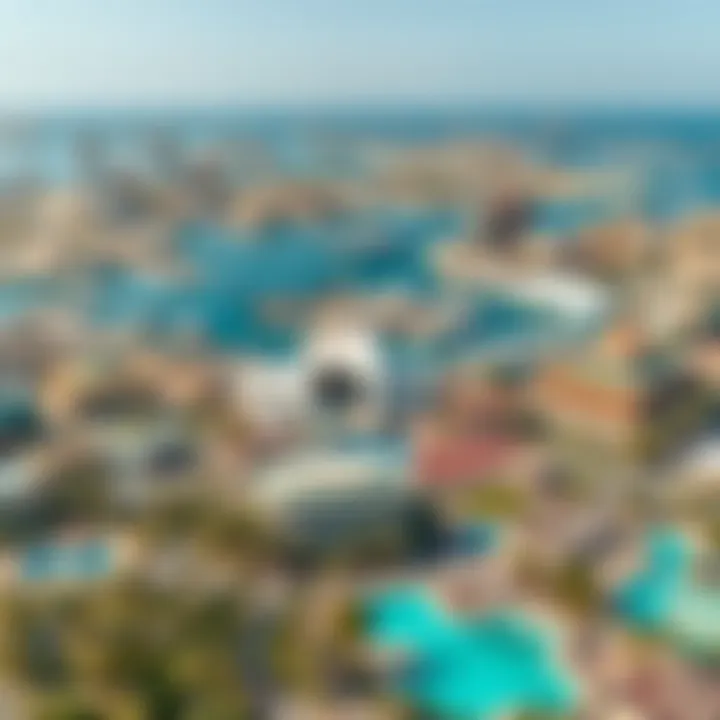
Intro
The Mediterranean-inspired sports city in Dubai is not just an architectural endeavor but a meticulous fusion of cultural nuances, lifestyle, and modern sporting facilities, designed to cater to the needs of residents, expatriates, and tourists alike. Nestled in one of the world’s most vibrant cities, this development aims to emulate the coastal charm and aesthetic grace of the Mediterranean region, while fostering community engagement and social integration. From its breathtaking architecture inspired by sun-soaked beaches and vibrant markets to its comprehensive sporting amenities, every aspect of this city speaks to collective aspirations.
As Dubai continues to evolve into a global hub for innovation and culture, integrating such a themed development reflects its ambition: to create spaces that are both functional and inspiring. This article delves into the myriad dimensions of this sports city, examining how it encapsulates the spirit of community, promotes health and wellness, while also serving as a tourist magnet.
Local Culture and Community
The fabric of a community is often woven with the threads of history, culture, and shared experiences. In this new sporting enclave, residents and visitors alike can partake in a variety of cultural festivals and events that celebrate both local customs and Mediterranean traditions. The attraction of Mediterranean festivals, echoing the vibrancy of life along the shores, will be a common sight.
Cultural Festivals and Events
With a calendar packed with events such as food fairs, art shows, and traditional music performances, the sports city invites people to come together and celebrate the diverse cultural tapestry of the region. Festivals showcasing Mediterranean cuisine will be particularly notable, bringing forth flavors that tantalize the palate, while art exhibitions highlight local talents and craft traditions.
Community Engagement and Activities
Community engagement will be further developed through organized sports events, workshops, and recreational activities designed to include people of all ages and skill levels. This isn't just about sports; it's about building relationships and fostering a sense of belonging among residents. Regular tournaments in football, basketball, and even coastal sports like beach volleyball will encourage interaction, making it easier for everyone to mingle and share stories.
Lifestyle and Amenities
A city is more than its buildings; it's about the lifestyle it offers. This Mediterranean-inspired sports city aims to curate an experience where leisure meets functionality.
Dining and Culinary Experiences
The culinary scene will play a pivotal role in shaping the daily lives of its residents. With a plethora of restaurants offering Mediterranean fare, diners can enjoy everything from fresh seafood to aromatic dishes infused with the essence of diverse culinary practices. Open-air dining spaces will evoke a familial atmosphere, encouraging people to sit back and indulge in comforting meals while making memories.
Recreational and Entertainment Options
Not only will this city be a haven for sports enthusiasts, but it will also boast an array of recreational and entertainment options. Parks dotted with Mediterranean flora will provide serene spots for leisure, while fitness centers equipped with state-of-the-art amenities cater to the health-conscious. Additionally, cinemas and performance arts venues will enrich the city's cultural offering, targeting a diverse audience.
The Mediterranean-inspired sports city in Dubai embodies the perfect blend of sport, culture, and lifestyle, reaching beyond the realm of mere aesthetics to foster a thriving community.
In summation, this ambitious project not only redefines the urban sporting landscape in Dubai but also integrates the essence of Mediterranean life, contributing to the city’s promise of progress and cultural richness. As Dubai continues to rise as a global urban center, such developments will become increasingly important for enhancing community ties and engaging a diverse population.
[Further details on Mediterranean architecture can be found at britannica.com]. [Explore cultural elements at en.wikipedia.org]. [Local events and festivals are discussed on platforms like facebook.com and reddit.com] [For more about Dubai's urban development projects, visit *.gov or *.edu sites relevant to city planning and architecture].
Prolusion to Mediterranean Building Concepts
The Mediterranean architectural style is more than just a design choice; it intertwines cultural heritage, climatic adaptation, and aesthetic appeal. In the context of a Mediterranean-inspired sports city in Dubai, understanding these concepts is pivotal. The design is not only visually captivating but also maximizes livability and environmental harmony. By infusing local culture with Mediterranean influences, this approach creates a unique identity for the city that resonates with both residents and visitors.
Defining Mediterranean Architecture
Mediterranean architecture is distinguished by its ability to blend functionality with beauty. Characterized by features such as:
- Red-tiled roofs – these steep roofs are not only a nod to history but also effective in directing rainwater.
- Stucco exteriors – a finish that helps keep homes cool in hot climates.
- Arched doorways and windows – these create an open, welcoming feel that encourages interaction.
These elements serve as a bridge between indoor and outdoor living, reflecting a lifestyle that values community and nature. While many cities can adapt Mediterranean styles, implementing this in Dubai—a hub of innovation and modernity—signals a strong narrative of sustainability and tradition.
Historical Context and Influence
The roots of Mediterranean architecture can be traced back centuries, blending influences from various cultures that have graced the region, such as the Greeks, Romans, and Moors. This rich history is reflected in a variety of construction techniques and materials, which have evolved over time yet retain their core functions.
In the context of Dubai, incorporating Mediterranean elements serves two primary purposes. First, it pays homage to the architectural richness that informs the modern skyline of countless coastal cities around the Mediterranean Sea. Second, it serves as a strategic response to the unique climate, harnessing architectural tools developed through centuries of adaptation to heat and sun.

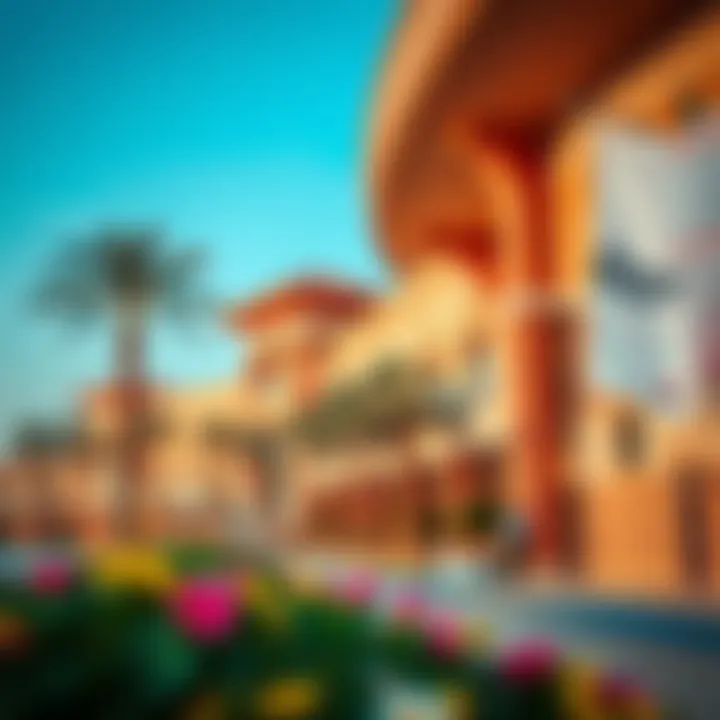
"Mediterranean architecture isn't just about the buildings; it's about reflecting a way of life that embraces nature and community."
This historic blending, when applied in the construction of a sports city, enhances not just aesthetics but builds a sense of belonging for its users. Understanding these historical influences aids in appreciating how the new structures will connect with the past while also meeting the crossroads of future urban development in Dubai.
Thus, as we explore the adjacent sections, from strategic planning to community integration, the importance of grounding the architectural vision in Mediterranean concepts becomes clearer. The aim is to create a cohesive environment that embodies both cultural significance and modern practicality while fostering a vibrant community.
Vision for a Sports City in Dubai
The concept of a sports city in Dubai does not merely encompass the physical space dedicated to athletics; it is a broader vision reflecting the aspirations of a city eager to position itself on the global map as a hub of sport, community, and culture. This vision entails a meticulously planned environment where sports and lifestyle converge, fostering a vibrant community that thrives on health, wellness, and active living. This undertaking isn't only about sports; it's about creating a unique atmosphere that invites residents, expatriates, and tourists to engage meaningfully with their surroundings.
"A sports city isn't just about fields and courts—it's about building a culture of fitness, community, and connection."
Strategic Planning and Development Goals
Strategic planning for this ambitious project involves a multipronged approach, aimed at ensuring sustainability, practicality, and community engagement. It is not just a matter of erecting buildings; it’s about weaving together various elements that serve the needs of a diverse population. The urban planners and architects have to consider:
- Sustainability: Utilizing resources efficiently while minimizing the environmental footprint is paramount. Incorporating renewable energies and sustainable materials can help achieve this goal.
- Accessibility: Ensuring easy transit access for both residents and visitors, possibly through a network of public transport options, bicycle lanes, and pedestrian walkways.
- Integrative Design: Creating spaces that seamlessly incorporate both indoor and outdoor facilities, promoting a year-round sports culture in a climate that can be challenging at times.
The development goals also underscore the need for multi-purpose venues. These facilities should cater to various sports and events, allowing for a flexible use that can adapt to changing trends. This flexibility enhances the potential for high attendance at events and community gatherings, thereby fostering a sense of belonging among residents.
Key Stakeholders and Their Roles
In any large-scale development effort, the input and alignment of various stakeholders can make or break the initiative. In this project, key players include:
- Government Bodies: They provide the necessary regulatory framework, zoning, and permits, ensuring that the project adheres to the city’s long-term goals.
- Architectural Firms: Tasked with translating the vision into reality, these firms bring expertise in Mediterranean design principles, ensuring aesthetic and functional excellence.
- Community Organizations: They play an essential role in ensuring the project reflects the needs and desires of those who will use it. Gathering feedback from local residents and sports enthusiasts is critical.
- Investors and Sponsors: They are crucial for the funding aspect, enabling high-quality construction and the creation of top-notch facilities.
By harmonizing these diverse perspectives, the sports city can become a thriving destination that not only elevates Dubai’s status but also enriches the lives of its inhabitants.
Architectural Design Principles
Architectural design principles form the backbone of any ambitious construction project, especially one as grand in vision as the Mediterranean-inspired sports city in Dubai. These principles do not merely dictate the aesthetic direction but also balance functionality, sustainability, and community interaction. As Dubai continues to evolve, such principles allow for a harmonious integration of modern structures with cultural values and environmental considerations. The design of the sports city holds endless opportunities not just for sporting events but also for cultural exchanges and everyday life.
Incorporating Natural Elements
When discussing natural elements in architecture, it’s essential to consider how these aspects can enhance the living experience. For the Mediterranean sports city, leveraging natural features isn’t merely an afterthought; it's a fundamental aspect woven into the fabric of the planning process. This involves understanding the local climate and how elements such as sunlight, breezes, and garden spaces can be integrated into daily use.
For instance, the incorporation of large windows and open-air designs permits natural light to flood interior spaces, reducing the need for artificial lighting and enhancing energy efficiency. Planting local flora not only beautifies the area but also provides shade in the hot Dubai sun. Furthermore, water features reflecting Mediterranean styles, like fountains and ponds, offer cooling effects, creating a serene atmosphere that contrasts sharply with the urban pace of the city. Such elements draw on local ecology and biodiversity, ensuring the design is in tune with the surroundings.
Color and Texture in Design
Color and texture play pivotal roles in defining the character of a space. In the Mediterranean context, bright whites, deep blues, and earthy tones reflect the region's landscapes. The use of these colors can evoke feelings of warmth, openness, and serenity while aligning with architectural traditions that speak to the rich tapestry of Mediterranean life.
Textures also count for much; smooth stucco, rough stone, and vibrant tile work offer sensory experiences that engage both sight and touch. Incorporating textured walls not only enhances the play of shadow and light but also helps to insulate buildings. Moreover, selecting materials that are durable yet visually appealing, like weather-resistant cladding that mimics traditional Mediterranean designs, brings authenticity and longevity to the construction.
Spatial Layout and Community Spaces
The spatial layout in a sports city significantly affects how individuals and communities interact with their environment. A thoughtfully designed layout can enable seamless transitions between private and public spaces, encouraging a vibrant, cohesive community. Here, the designers can prioritize multi-use areas, ensuring that spaces serve various functions at different times of day.
For instance, a central plaza where residents can gather for social events or cultural programs can serve multiple purposes. Surrounding the plaza with retail options, cafes, and community facilities fosters social exchanges and enriches the locale. When people feel a sense of ownership and connection to their spaces, it leads to greater community engagement and pride.
Incorporating sports facilities throughout the city encourages outdoor activity, providing citizens with spaces to exercise, socialize, or simply enjoy the environment. Such spatial designs can implement pathways connecting homes with parks and sports centers, enhancing mobility and accessibility while also promoting a healthier lifestyle.
By embedding these architectural design principles into the Mediterranean-inspired sports city, planners are creating not just a collection of buildings and venues but a thriving ecosystem. This intentional approach makes the community more than just a place to live; it creates a vibrant, integrated habitat reflective of both Dubai's aspirations and Mediterranean heritage.
"Good architecture speaks of its time and place, but it also points toward the future." - A quote that resonantes with future developments.
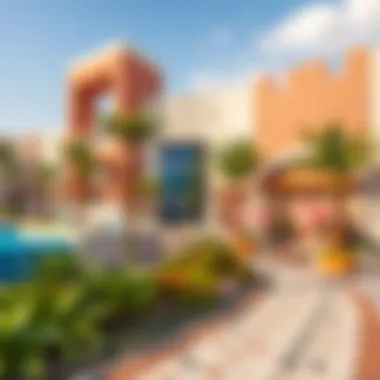
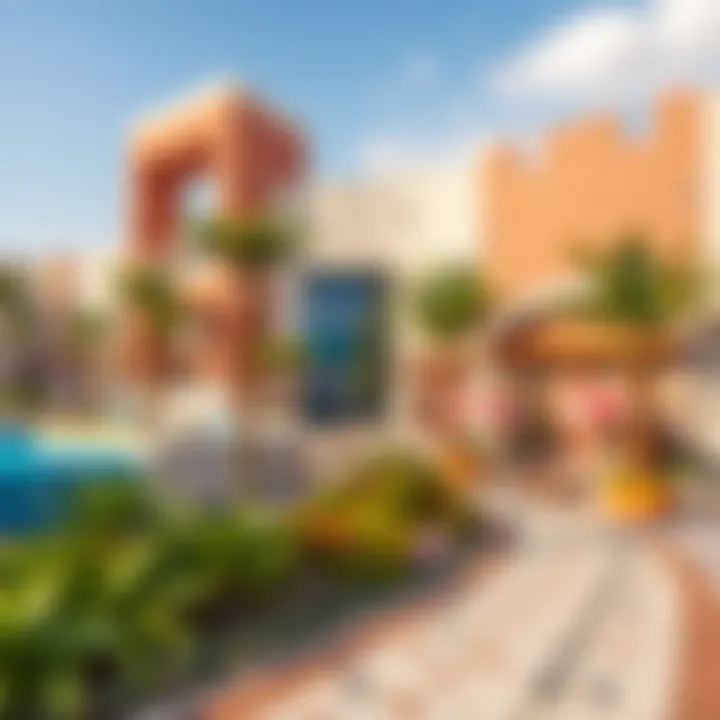
For further reading on architectural principles, refer to Wikipedia on Architecture and Britannica for Design Principles.
Ensure to explore how integrating these principles can reshape Dubai not only for its residents but also for tourists and expatriates, creating spaces that reflect beauty, culture, and functionality.
Sporting Facilities Overview
The development of the Mediterranean-inspired sports city in Dubai is not merely about buildings and landscaping. The sporting facilities included in the design play a pivotal role in the overall vision, shaping the community and enhancing the quality of life for residents and visitors alike. These facilities are designed to attract both amateurs and professionals, providing spaces where talent can blossom and where enjoyment of sports can prevail. With state-of-the-art design and architecture, these complexes aim to foster a vibrant life centered around health, recreation, and community.
- Sports facilities are the heart of this city's vision, marrying culture and performance in a unique environment.
Multi-Purpose Sports Complexes
Multi-purpose sports complexes stand at the forefront of the Mediterranean sports city. They serve as adaptable venues that can host a myriad of sports, including basketball, tennis, swimming, and even indoor athletics. The innovative design allows for these spaces to be transformed quickly based on the needs of the event, making them suitable for everything from local leagues to international tournaments. An essential aspect is the ability of these complexes to cater to diverse groups, ensuring accessibility for all. Families can come together for weekend events, while professional teams can utilize the same space for training and competitions. The potential for community engagement is enormous, as regular events and workshops can transform these complexes into vibrant community hubs that enhance social interaction and promote physical fitness.
Stadiums and Arenas
The stadiums and arenas built within the sports city are monumental representations of both architectural prowess and sporting ambition. Designed not only to accommodate thousands of spectators but to create an immersive experience, these venues take into account aspects like acoustic engineering, sightlines, and crowd flow. Stadiums, like the one envisioned for hosting international matches, feature top-tier technology to enrich the spectator experience. This includes high-resolution screens, advanced sound systems, and upgraded facilities to ensure comfort. Moreover, these venues will be versatile, meaning they could equally host concerts or cultural events, making them integral to Dubai's cultural landscape. The aim is to create a destination that not just showcases sports but also becomes a landmark of entertainment and leisure.
Training Centers for Athletes
Training centers for athletes form the backbone of performance training in this Mediterranean-inspired scheme. Designed with cutting-edge facilities, these centers focus on providing athletes with the tools they need to excel in their sports. Equipped with specialized equipment, nutrition guidance, and expert coaching staff, these training centers will cater to various disciplines. These facilities are not exclusive to elite athletes. Community programs can leverage these centers for training sessions, fostering talent at the grassroots level. Workshops on sports science and nutrition provide practical knowledge for aspiring athletes and health-conscious individuals alike. This focus on education and training embodies a commitment to nurturing local talent while boosting community engagement. It also reflects a belief that a sound mind and body can flourish through physical activity and education.
Community Integration and Lifestyle Benefits
The Mediterranean-Inspired Sports City in Dubai is more than just a design marvel; it serves as a blueprint for fostering community integration and enhancing lifestyle benefits. In an era where urban diversity is at its peak, creating spaces that enhance community cohesion and improve quality of life has become crucial. The design of this city, rooted in Mediterranean values, focuses on bringing people together while promoting an active lifestyle.
Residential Offerings and Amenities
Diverse residential offerings are essential in attracting a wide range of residents, from local families to international expatriates. The city features an eclectic mix of housing options, each thoughtfully designed to reflect Mediterranean architecture, characterized by open floor plans, natural light, and large terraces. The availability of amenities such as grocery stores, cafes, and health clubs within close proximity fosters a sense of convenience.
Furthermore, residential neighborhoods are connected by tree-lined streets, promoting a leisurely walkability that mirrors communities along the Mediterranean coast. Homes might also include:
- Spacious balconies that allow for outdoor living, similar to southern European lifestyles.
- Shared community gardens where residents can engage with nature and each other.
- Dedicated play areas for children that encourage social interactions among families.
These offerings not only provide quality dwellings but also engender a vibrant community atmosphere.
Public Spaces for Social Interaction
Public spaces are the lifeblood of any community, serving as the area where social life unfolds. The Mediterranean-Inspired Sports City boasts an impressive range of public spaces designed to encourage social interaction. Think bustling plazas where local markets might be held, or urban parks that provide green oases in the heart of the city. These spaces are rooted in the idea that the environment can stimulate connections among residents and visitors alike.
- Community parks serve as venues for outdoor events and cultural gatherings, facilitating community bonding and cultural exchange.
- Open sports facilities allow for casual games and sports lessons, fostering friendships and cooperation.
- Artistic installations that capture the essence of the Mediterranean culture spark conversations and collaborations, turning casual visitors into engaged community members.
"Public spaces have the power to transform how we interact and connect in our urban environments. In this city, they are designed to cultivate relationships."
In summary, the Mediterranean-Inspired Sports City in Dubai is not merely an architectural achievement; it’s a living testament to how thoughtfully designed residential amenities and public spaces can enhance community integration and raise the overall quality of life. Integrating lifestyle benefits into urban planning can lead to a more vibrant, interconnected community where various cultures meld harmoniously.
Cultural Significance of the Design
The cultural fabric of a community is often seen as an intricate tapestry woven from shared experiences, history, and aspirations. When exploring the design of a Mediterranean-inspired sports city in Dubai, the significance of culture takes center stage. This architectural endeavor does not merely serve as a backdrop for athletic events; it embodies a way for residents and visitors alike to engage with the various elements that define their cultural identity. This project aims to foster connections through spaces that facilitate cultural exchange, recreation, and social gathering, truly enriching the lives of those who experience it.
Fostering a Sense of Place
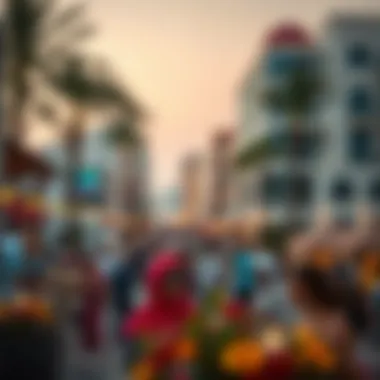
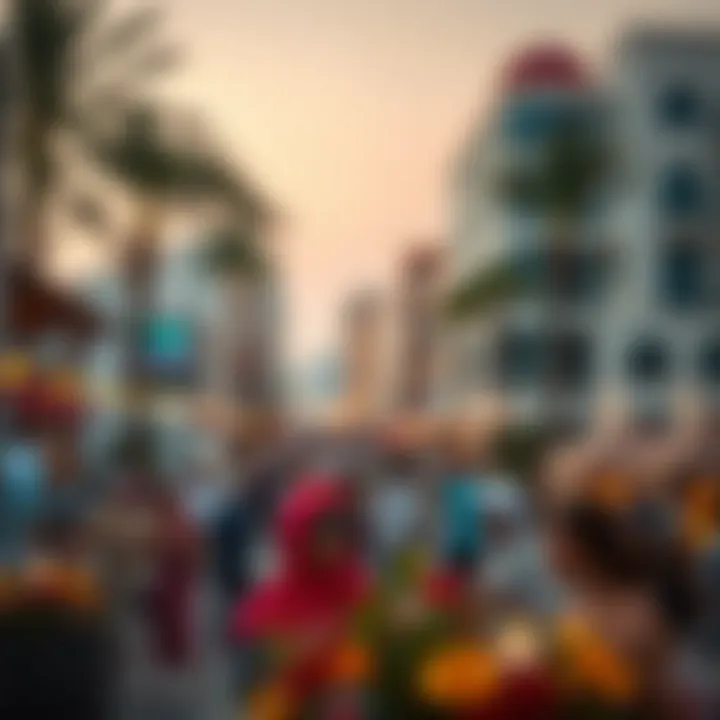
Incorporating elements that resonate with the Mediterranean spirit, the design seeks to create a strong sense of place. Often, buildings that embody a particular architectural style resonate more deeply with their users. This project aims to do just that, melding the aesthetic beauty of Mediterranean architecture with Dubai's unique environment. The soft hues of terracotta, the organic shapes of the buildings, and the welcoming plazas imbue the area with a sense of warmth that encourages people to linger and explore.
Moreover, the spatial layout is crucial in nurturing this connection. Wide-open spaces invite social interaction, while strategic landscaping integrates natural elements, crafting an oasis within the urban landscape. Each corner of the sports city tells a story, often reflecting the history and culture not just of Dubai, but also of the Mediterranean region, bridging the gap between diverse backgrounds.
Cultural Programs and Events
Events, programs, and exhibitions play a pivotal role in cementing the cultural significance of the sports city. The collaboration between local artists, sports organizations, and community members will give rise to a series of cultural initiatives. An exciting example is the potential for hosting international festivals that celebrate Mediterranean cuisine, music, and traditions, enriching the community’s cultural offerings.
These events not only showcase the vibrancy of the Mediterranean cultures but also serve as platforms for intercultural dialogue. Workshops focused on traditional craftsmanship, cooking classes highlighting Mediterranean culinary arts, and sports clinics can drive participation from wider audiences. Hence, the Mediterranean-inspired sports city is poised to become a cultural hub, where every event fosters collaboration amongst residents and visitors alike, resulting in a more cohesive community.
"Cultural exchange through events strengthens the ties that bind us, creating a community that thrives in diversity."
In summary, the Mediterranean-inspired sports city represents much more than just a physical space; it is a vibrant ecosystem of cultural significance, where a shared sense of place is paramount, and cultural programs help to sustain it. This synergy positions the city not only as a center for sport but also as a beacon of cultural richness in Dubai, enhancing the allure for residents, expatriates, and tourists.
Potential Challenges and Considerations
The development of a Mediterranean-inspired sports city in Dubai brings an exciting vision yet comes with its share of hurdles. Understanding these potential challenges is crucial. Addressing economic viability and environmental impact assessments will not only help to ensure the project’s success but also serve as a roadmap as Dubai positions itself in the global arena.
Economic Viability and Investment
Economic viability is a cornerstone of any large-scale urban project. It’s not just about throwing money at a problem. Investors need to see the long-term benefits, while local governments must ensure this project aligns with their financial goals.
This sports city aims to attract tourists and expatriates alike, yet the question remains—will it generate enough revenue? For instance, projections of visitor numbers can guide everything from pricing strategies for events to the kind of facilities to offer. A well-rounded financial plan is key, encompassing aspects like operational costs and maintenance budgets.
To sweeten the deal for investors, public-private partnerships could play a significant role. Engaging private entities can lead to innovations and efficiencies that might not be achievable in a strictly public-run approach. By leveraging funds from private developers while maintaining public oversight, the balance between profit and community benefit might just be attainable.
"Economic sustainability isn't just a buzzword; it's the backbone of urban development."
Additionally, understanding the local economy’s pulse ensures that development plans complement existng socioeconomic landscapes. For example, ensuring that local businesses benefit from the influx of visitors could form part of a broader strategy. Creating a symbiotic relationship can elevate both the sports city and surrounding neighborhoods, fostering economic growth for all.
Environmental Impact Assessments
With the rising tide of climate change awareness, environmental impact assessments (EIAs) are no longer optional but essential. These assessments evaluate the potential environmental consequences of constructing a sports city. Not only do they examine existing ecological conditions, they also provide insights into how construction and development can mitigate adverse effects.
An ideal EIA would focus on several aspects:
- Air Quality: How will construction affect air quality in and around the city?
- Biodiversity: What measures will be undertaken to protect local flora and fauna?
- Water Management: How will the project deal with water resources, particularly in a desert environment?
Properly executed, an EIA not only informs regulations but also aids builders in adopting eco-friendly technologies. For example, solar panels could make facilities self-sufficient in energy, aligning with both economic and environmental goals.
Ultimately, these challenges, while daunting, offer opportunities for innovation. By addressing the economic viability and conducting thorough environmental impact assessments, Dubai can set a benchmark for future urban developments. It is a chance not only to build a sports city but also to lay down foundational principles for sustainable urban living in a changing world.
Future Prospects and Expansion
The Mediterranean-inspired sports city in Dubai is poised to be more than just a marvel of architecture — it's a glimpse into the future of urban development. Understanding and harnessing the potential for expansion is crucial for the sustained growth of this project and for its integration into the local fabric.
Adapting to Changing Trends in Sports
As we move deeper into the 21st century, the sports landscape is continually shifting. The preferences of athletes and spectators are no longer static; rather, they evolve with advancements in technology, changes in lifestyle, and the emergence of new sports. Hence, the sports city must be designed with a flexible framework that allows for the incorporation of these trends.
- Emerging Sports: The inclusion of sports like eSports and adventure sports can attract a younger demographic. Facilities within the sports city may need to adapt or expand to accommodate these new activities.
- Sustainability Practices: There is an increasing priority on eco-friendly initiatives. Future upgrades can include renewable energy sources, water-efficient systems, and environmentally friendly materials during renovations.
- Smart Technology Integration: Utilizing smart technology in training centers and arenas ensures that athletes have access to data analytics and performance optimization tools. Being proactive in adopting such innovations can keep Dubai's sports city at the forefront of sports excellence.
The need to remain versatile in offerings will likely enhance the city’s appeal and economic viability over time. Realizing this can prevent stagnation, thus ensuring that the city vibrantly resonates with both local and international audiences, fostering an environment of continuous engagement.
Long-Term Urban Development Goals
In establishing long-term urban development ambitions, the sports city must align itself with Dubai's broader vision. The continuity of urbanization—essentially, blending working, living, and recreational spaces —is imperative.
- Cohesive Community Spaces: Designing areas that promote community interaction can transform the sports city into a cultural hub, attracting not just sports enthusiasts but families, tourists, and expatriates. Think of parks interspersed with sporting venues, where people can unwind or engage in recreational activities themselves.
- Transport Infrastructure Improvements: Seamless connectivity through efficient transport systems will be crucial. Future expansions could integrate advanced public transport options like the Metro or tram systems to ease access to the city.
- Economic Impact and Job Creation: A focus on developing businesses that cater to sports and leisure—like retail, hospitality, and dining—will stimulate job creation. The potential for attracting global sporting events could bolster tourism activities, creating a positive ripple effect through the economy.
To encapsulate, the long-term prospects and expansion of the Mediterranean-influenced sports city in Dubai hold immense promise. The ongoing dialogue between local culture and international influences can create an inclusive, thriving atmosphere that stands the test of time.



